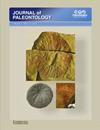Review and revision of the Olivoidea (Neogastropoda) from the Paleocene and Eocene of the U.S. Gulf Coastal Plain
IF 1.6
4区 地球科学
Q3 PALEONTOLOGY
引用次数: 0
Abstract
Abstract Numerous species of “oliviform” gastropods have been recognized in the Paleogene of the U.S. Gulf Coastal Plain, many of which have previously been allied to the “Bullia group” in the family Nassariidae, and placed in a variety of poorly defined genera. We review these species, revise their generic and familial placement, and present a phylogenetic analysis. Of 19 species considered valid, all are assigned to Olivoidea, six to Olividae—one to Oliva, five to Agaronia—and the rest to Ancillariidae. The highly variable species Ancillaria altile Conrad is referred in the genus Ancillopsis and appears to have evolved anagenetically over an interval of perhaps 20 million years. Ancillaria tenera Conrad and Ancillaria scamba Conrad are placed in the new genus Palmoliva. Monoptygma Lea is demonstrated to belong to Ancillariidae, and to contain only a single species. Specimens assigned to Lisbonia expansa Palmer are split into adults assigned to Ancillopsis altilis and juveniles (together with several other species) in the long-lived species Anbullina elliptica (Whitfield). Coastal Plain ancillariids may have evolved from one or more species of the Cretaceous–Paleocene genus Eoancilla. We agree with previous authors who have suggested that the late Eocene species Oliva mississippiensis Conrad is the earliest known representative of this genus and the subfamily Oliviinae, perhaps derived from a species of Agaronia. The oldest Agaronia is lower Eocene (Ypresian). UUID: http://zoobank.org/b7d9f79b-c68b-4385-aba3-bb07c6d6dc87美国海湾海岸平原古新世和始新世橄榄总科(新腹足目)的回顾和修订
摘要:在美国墨西哥湾沿岸平原的古近系,已经发现了许多“橄榄形”腹足类动物,其中许多物种以前被归入Nassariidae科的“Bullia群”,并被归入各种定义不明确的属。我们回顾了这些物种,修改了它们的属和科的位置,并提出了系统发育分析。在被认为有效的19种中,所有的种类都被归为橄榄总科,6种归为橄榄科,1种归为橄榄科,5种归为花椰菜科,其余归为针叶虫科。高度可变的物种安希利亚(anillaria altile Conrad)属于安希利亚属,似乎在大约2000万年的时间间隔内进行了无性进化。附属物tenera Conrad和scamba Conrad被归入Palmoliva新属。Monoptygma Lea被证明属于副虫科,并且只包含一个物种。属于扩张Lisbonia expansa Palmer的标本被分为属于anillopsis altilis的成虫和属于长寿物种Anbullina elliptica (Whitfield)的幼虫(连同其他几个物种)。沿海平原的副鳃虫可能是从白垩纪-古新世古副鳃虫属的一种或多种进化而来。我们同意前人提出的始新世晚期橄榄属(Oliva密西西比)Conrad是该属和橄榄亚科最早的代表,可能起源于一种Agaronia。最古老的Agaronia是始新世晚期(伊波斯)。UUID: http://zoobank.org/b7d9f79b - c68b - 4385 aba3 bb07c6d6dc87
本文章由计算机程序翻译,如有差异,请以英文原文为准。
求助全文
约1分钟内获得全文
求助全文
来源期刊

Journal of Paleontology
地学-古生物学
CiteScore
2.80
自引率
7.10%
发文量
94
审稿时长
6-12 weeks
期刊介绍:
The Journal of Paleontology publishes original articles and notes on the systematics, phylogeny, paleoecology, paleogeography, and evolution of fossil organisms. It emphasizes specimen-based research and features high quality illustrations. All taxonomic groups are treated, including invertebrates, microfossils, plants, vertebrates, and ichnofossils.
 求助内容:
求助内容: 应助结果提醒方式:
应助结果提醒方式:


